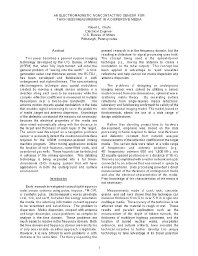 |
his paper describes a general purpose imaging technology developed by the U.S. Bureau of Mines (USBM) that, when fully implemented, will solve the general problem of "seeing into the earth." A first generation radar coal thickness sensor, the RCTS-1, has been developed and field-tested in both underground and highwall mines. The noncontacting electromagnetic technique uses spatial modulation created by moving a simple sensor antenna in a direction along each axes to be measured while the complex reflection coefficient is measured at multiple frequencies over a two-to-one bandwidth. The antenna motion imparts spatial modulation to the data that enables signal processing to solve the problems of media, target and antenna dispersion. Knowledge of the dielectric constant of the media is not necessary because the electrical properties of the media are determined automatically along with the distance to the target and thickness of each layer of the target. The sensor was developed as a navigation guidance sensor to accurately detect the coal/noncoal interface required for the USBM computer-assisted mining machine program. Other mining applications include the location of rock fractures, water-filled voids, and abandoned gas wells. These hazards can be detected in advance of the mining operation. This initiating technology is being expanded into a full threedimensional (3-D) imaging system that will have applications in both the underground and surface environment.
| Author(s): | Chufo-RL |
| Reference: | Proc AIAA/NASA Conference on Intelligent Robots in Field, Factory, Service, and Space (CIFFSS 94) 1994 Mar 21-24 Jon D. Erickson, Houston, TX 1:190-194 |
aensf (PDF, 141 KB)